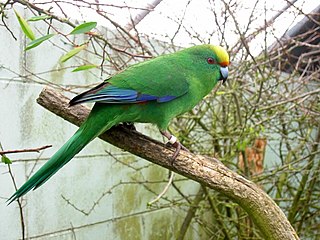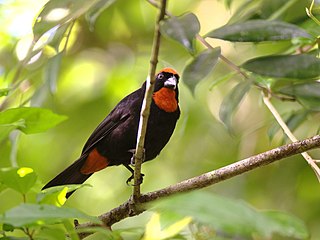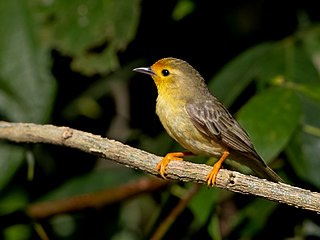
The Eurasian bullfinch, common bullfinch or bullfinch is a small passerine bird in the finch family, Fringillidae. In Anglophone Europe it is known simply as the bullfinch, as it is the original bird to bear the name bullfinch.

The pine grosbeak is a large member of the true finch family, Fringillidae. It is the only species in the genus Pinicola. It is found in coniferous woods across Alaska, the western mountains of the United States, Canada, and in subarctic Fennoscandia and across the Palearctic to Siberia. The species is a frugivore, especially in winter, favoring small fruits, such as rowans. With fruit-crop abundance varying from year to year, pine grosbeak is one of many subarctic-resident bird species that exhibit irruptive behavior. In irruption years, individuals can move long distances in search of suitable food supplies, bringing them farther south and/or downslope than is typical of years with large fruit crops.

Betula pendula, commonly known as silver birch, warty birch, European white birch, or East Asian white birch, is a species of tree in the family Betulaceae, native to Europe and parts of Asia, though in southern Europe, it is only found at higher altitudes. Its range extends into Siberia, China, and southwest Asia in the mountains of northern Turkey, the Caucasus, and northern Iran. It has been introduced into North America, where it is known as the European white birch or weeping birch and is considered invasive in some states in the United States and parts of Canada. The tree can also be found in more temperate regions of Australia.

Malherbe's parakeet is a small parrot endemic to New Zealand, where it is known as the orange-fronted parakeet or orange-fronted kākāriki. In the rest of the world it is called Malherbe's parakeet, as when it was recognised as a species, the name "orange-fronted parakeet" was already used for Eupsittula canicularis, a Central American species. Restricted to a few valleys in the South Island and four offshore islands, its population declined to around 200 in the 1990s, and it is considered critically endangered by the IUCN.

Pyrrhula is a small genus of passerine birds, commonly called bullfinches, belonging to the finch family (Fringillidae). The genus has a Palearctic distribution; almost all species occur in Asia, with two species exclusively in the Himalayas and one species, P. pyrrhula, also occurring in Europe. The Azores bullfinch is a critically endangered species, occurring only in the east of the island of São Miguel in the Azores archipelago.

Cabot's tragopan is a pheasant found in south-east China. The common and scientific names of this large bird both commemorate the ornithologist Samuel Cabot III. Other common names include the Chinese tragopan and the yellow-bellied tragopan. The population is divided into two subspecies, of which the dominant subspecies is found in the provinces of Fujian, Jiangxi, Zhejiang, and Guangdong, and T. c. guangxiensis is confined to northeastern Guangxi and southern Hunan. The IUCN has assessed it as being a "vulnerable species".

The Azores bullfinch, also known as the São Miguel bullfinch, or locally in Portuguese as the priolo, is a threatened passerine bird in the true finch family. It is endemic to São Miguel Island, in the Azores archipelago of Macaronesia in the North Atlantic Ocean.
Bullfinch is a name given to two groups of passerine birds.

The Puerto Rican bullfinch is a small bullfinch tanager endemic to the archipelago of Puerto Rico. The species can be commonly found in heavy forests throughout Puerto Rico, except on the easternmost tip of the island. It consumes seeds, fruits, insects, and spiders. The nest is spherical, with an entrance on the side. Typically three light green eggs are laid.

The pink-billed parrotfinch is a species of estrildid finch found on the island of Viti Levu, Fiji. Commonly found at undisturbed mature forest in the centre and east of Viti Levu, e.g. Joske's Thumb near Suva. This species is found at mid-height along tree-trunks and branches, usually alone or in pairs but also joining mixed-species flocks, feeding primarily on insects, but also on flower buds and fruits.

The ʻakekeʻe or Kaua'i 'akepa is a bird species in the family Fringillidae, where it is placed in the Hawaiian honeycreeper genus Loxops. It is endemic to the island of Kauaʻi where it is found in small numbers in higher elevations. Because of their similar size, shape, and unusual bill, the ʻakekeʻe and the ʻakepa were for some time classified as a single species. This was eventually changed, because of differences in their color, nesting behavior, and calls. The 'akeke'e is extremely threatened and is predicted to face imminent extinction if mosquito control efforts on Kaua'i are not implemented.

The grey-headed bullfinch is a species of finch in the family Fringillidae. It is sometimes known as Beavan's bullfinch.

The red-headed bullfinch is a species of finch in the family Fringillidae, found all across the Himalayas and adjacent highlands. It is found in Bhutan, northern India, Nepal and adjacent southern Tibet. Its natural habitat is temperate forests.

The white-cheeked bullfinch is a species of finch in the family Fringillidae.

The brown bullfinch is a species of bird in the true finch family, Fringillidae. It is found in Bhutan, China, India, Malaysia, Myanmar, Nepal, Pakistan, Taiwan, and Vietnam. Its natural habitats are temperate forest and subtropical or tropical moist montane forest.
Picea aurantiaca is a species of conifer in the pine family, Pinaceae. It is endemic to China, where it is only known from western Sichuan. Its common name is orange spruce.

The orange oriole is a small bird species with orange feathers native to the Icteridae family in the Yucatán Peninsula. It has a slender body, long wings, and a pointed beak. Its color resembles the fruit orange, and it has black markings on its wings and tail. The orange oriole is known for its song and can be found in forests and gardens. They have a diverse diet that contributes to their color. According to The Cornell Lab of Ornithology Birds of the World, they have suggested that this species might be better named the “Yucatan Oriole” because they are only found in Southeast Mexico. This species is not endangered and least threatened.

The orange-fronted plushcrown is a species of bird in the Furnariinae subfamily of the ovenbird family Furnariidae. It is found in Bolivia, Brazil, Colombia, Ecuador, and Peru.

The equatorial greytail is a Near Threatened species of bird in the Furnariinae subfamily of the ovenbird family Furnariidae. It is found in Ecuador and Peru.

The Baikal bullfinch, also known as the grey bullfinch, grey-headed bullfinch or great bullfinch, is a small passerine bird in the finch family Fringillidae. It is found in eastern Kazakhstan, Mongolia and adjacent areas of Russia and China. Although sometimes considered a full species, most authorities treat it a subspecies of the Eurasian bullfinch. It migrates altitudinally from its summer breeding range in the Altai Mountains to its winter range in the adjacent foothills and plains.


















